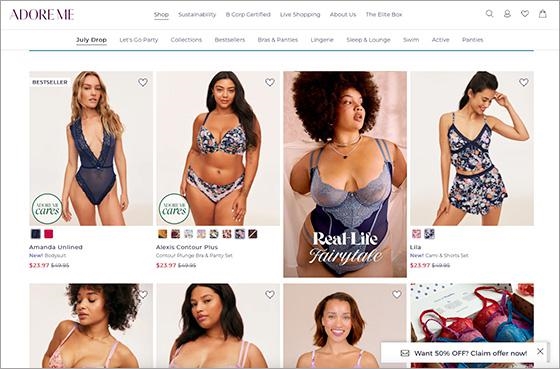Persistent and Personalized: Adore Me Sees AI Opening New Relationships With Customers

At our Spring edition of the Brand Insider Summit: D2C, Adore Me’s Ranjan Roy proved an excellent guide to the promise of generative AI for e-commerce processes. Everyone is testing and learning how to use these tools. But Adore Me started early and is already working it into its workflows to various degrees. We followed up with him recently to dig into all of the ways he sees AI opening up new pathways of persistent and personalized communication with customers – a different e-commerce experience.
Ranjan comes to this topic genuinely informed rather than simply dazed and dazzled by it. At a previous startup he worked on natural language processing and automated summation technologies. He’s taught at the City University of New York and co-founded the consultancy The Edge Group as well as Informerly. You can listed to the entire podcast at this link.
MP: So how do you explain to your fellow marketers the two key challenges of AI for most of us – what’s actually going on in this black box so that you can maybe influence what it does, but then, imagining the things it can do for you?

Roy: Back in like 2015 when we started experimenting with this stuff, I asked one of the engineers on our team to explain to me natural language generation. He started saying stuff around vectors and other kinds of complex topics. And then he said how about this? This is all about prediction. And he said peanut butter and… jelly, obviously. And then he’s like, okay. So, you knew that you predicted it. Everyone kind of knows, we have been trained over and over again that peanut butter and the next word is jelly, with nearly a hundred percent accuracy. But basically, given a context, predicting what the correct next word is, that’s all any of this is. It’s all just prediction based on some larger context. Once you start to think of it like that, then you start to see what’s important to be able to enable that prediction.
On the marketing side, you need good data. The quality of what you’re inputting is going to determine the quality of what you’re getting out of it. So again, this stuff will not magically solve problems for you. The better the data you have to go in, the better the output you’ll get. But then also you have to be understanding what the right prompt is, like what are you actually looking for? What are you trying to get out of it? Just saying, I want a product description is not going to be enough. It is I want this product description to have these attributes and these features and serve this purpose for this type of customer. It takes a lot of work to get a good output.
MP: How do you organize internally around this? So, you’ve got hundreds of people at your own company who are probably playing with it in their own way. You want people to play to learn but need to maintain some internal discipline and order.
Roy: We have taken the task force approach in some ways. Again, on the media buy and acquisition side, we created a small group. And there it’s interesting because it was like playing with both images and text. On the copywriting team, I’ve gotten them interested, involved since last Fall. But then, on the technology side, we have a very large engineering department. They both built internal task forces to try to encourage experimentation. And then at a high level, we’re discussing as a company what’s our centralized approach to this, because clearly the compliance side of it, the ethics side of it, the responsibility side of it — there’s a lot of things we have to have firm policy around. But there’re a few different layers of this. There’s the playing side — make funny images and make funny song lyrics in ChatGPT. But that’s actually still important, because the more people do that, the more familiar they are.
Then the second bucket is kind of how do you integrate this into your existing workflows? And this is where even Google released in Docs and Gmail generative features that we’ve been testing.
The third bucket is transforming your workflows. That’s building the tools and processes to automate things like product descriptions. That’s still hacked together, case by case. And we think we’re still pretty far ahead in terms of having some of these things already operationalized.

MP: Speaking of risks, one of the things that you spoke about at the D2C Summit is risk assessment. How are you going about it?
Roy: We basically made a classic 2 by 2 matrix. On one axis, it was revenue risk, and then the other it’s how structured is something. Meaning, again, product descriptions. [They] are incredibly structured. There’s set attributes that make it in, there’s a repetitive kind of function framework for the copy. Email subject lines — fairly structured. But those two have very different revenue risks for us. Email is a huge driver of revenue for us, so you can’t screw up email subject lines. We currently use AI for just ideation. But we’re not to the point where we’re comfortable definitely populating an email subject line and taking that kind of risk when it’s so important for us. Product descriptions are important, but they’re not going to necessarily make or break that level of sales. They certainly have to be good, and you have to be careful. But you have significantly less direct revenue impact.
And I think that’s the way everyone needs to think about these technologies. The more revenue at risk, the more you need to have people in the loop, you have to be extra careful, you have to iterate on the model and get it better and better. And again, it’s having like a clear prioritization around these different axes is important.
MP: So where are you actually using it right now at Adore Me?
Roy: A couple of different areas. So again, product descriptions were like the biggest use case. Not only did it we get to the point of it saving time, but it actually has had benefits far beyond what an individual or even a team of people could have done. But then, also again, email on the subject line, we’re still using it for ideas, but not to actually populate the email. Another area is a service of ours called Daily Look. It’s a styling box service, and there’s a person who styles your box and writes a note, and they write it from scratch. It’s actually integrated into the workflow giving people a first draft based on the items in the box. That is an area where I’m pretty excited, because that’s a lot more complex to populate these first drafts, but it’s been going pretty well. Elsewhere again, I would still put in the experimentation phase.

MP: So, most of the talk, and I think you focused a lot of your talk at D2C Summit, was about AI offering marketers’ efficiencies. Where in e-commerce will it be transformative, improve the shopping experience for users, or just the relationship between a brand and its customers?
Roy: For any kind of online shopping the goal is to minimize the interactions with the customer. From a pure economic standpoint, the more interaction you have, the more expensive it is. To me the most exciting part of this is, it almost flips the equation where creating more non-conversion-oriented communications is something that every brand can start investing in. We’ve been talking about this a lot. It’s like, after the point of purchase. getting communications around product care that are super personalized to the person, to the size of the outfit. Has it been three months, has it been six months since they got the product? There’s so much that can be done that in the past you would have not necessarily invested the time in, because it would be too expensive. I think that starts to get very interesting, and that also changes the entire relationship with the shopper. Right now for almost every online brand the majority of your communications are still around some kind of selling. So, the idea that you can then start actually investing heavily into more value additive communications, I think that can really change the relationship people have with a brand.
MP: Well, let me take my own good advice here, and make sure we talk about something other than AI. What marketing projects or new things are you working on hardest to Adore Me now?
Roy: Loyalty and retention are top of mind in 2023. For Adore Me, we’ve had membership models. A membership is a huge core part of our business. But basically, I think the entire e-commerce industry, the need to acquire customers over and over again, rather than having built in ways to have people shop-repeat — I think that has to be priority for every direct consumer brand, and it certainly is for us.
(6)







